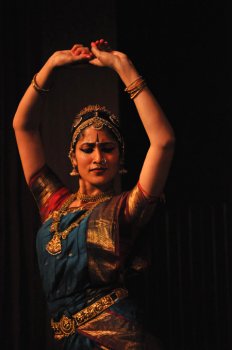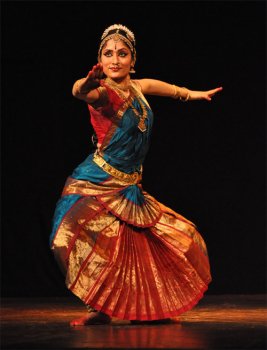
|   |

|   |
A sedate performance - A Seshan, Mumbai e-mail: anseshan@gmail.com Photo: Abhinaya January 18, 2011 Sur Singar Samsad, Mumbai, has been conducting an annual Swami Haridas Sangeet Sammelan for more than a half century. The 54th edition from January 13 to 24 features 75 young artistes in the fields of classical music – both vocal and instrumental - and dances of various styles. It is a massive effort. There was a time when the festival was well attended. It had its high noon during the time when Shri Brijnarainji, the founder, was organizing it. However, over the years, the event has ceased to attract rasikas to the extent it did in the past. I understand that this is due to a lack of publicity. A simple and short advertisement in a popular daily in Mumbai costs a fortune. The proliferation of sangeeta sabhas all over the city has affected many institutions adversely, as people move from one area to another after marriage or retirement. Corporate support is hard to come by due to competing demands from a number of organisations. The few concerts at the Sammelan attended by me in recent years had hardly 100 members in the audience at the Vidyapith Vidyarthi Bhavan of the University of Mumbai in Churchgate. The organisers of the SSS are bravehearts and they should be congratulated for persisting with their efforts to serve the cause of music and dance despite heavy odds. The aficionados of music and dance in Mumbai owe a debt of gratitude to them. They could perhaps find ways of publicizing the festival among students through notices displayed in the educational institutions in nearby areas.   The long introduction has been provoked by the low attendance at an interesting and thoroughly professional Bharatanatyam performance on January 15, 2011. The artiste was Dr. Janaki Rangarajan, who has been busy in the concert circuit in the recent years as an upcoming dancer of repute. The programme had an added attraction to me as it had the elements of Margam, the revival of which I have been propagating. I saw a jatiswaram after a long time. It was a refreshing experience. Due to short-duration (around 40 minutes) only selected elements of the traditional paddhati could be presented but what was on stage was thoroughly enjoyable. With clever programming, she tried to satisfy the cosmopolitan audience. The items were a jatiswaram in Ragamalikai composed by the Tanjore Quartet, a pasuram in Tamil of Kulasekhara Alwar in the nature of a lullaby sung to baby Rama in Ragamalikai that was followed immediately by a Tulsidas bhajan ("Thumak Chalat Ramchandra") and concluded with a tillana in Pharas of Poochi Srinivasa Iyengar. Within the limited time, she could provide for a variety of talas – misra chapu, tisra ekam and adi, in that order. The inclusion of a well-known Tulasidas bhajan was imaginative as there were many non-Tamil members in the audience. The jatiswaram gave an ample display of Janaki's command of nritta. The carrying of the baby Rama, caressing it, and putting it to sleep in the pasusram piece were all done with vatsalya as the dominant stayibhava that carried conviction with the audience. In view of the time factor, sancharis with storytelling had to be limited. The tillana was a standard one with all the elements of addami, footwork and statuesque poses intact. In a nutshell, the whole programme was characterized by artistic adavus with angasuddha, subdued skalitams and right sense of rhythm. A few karanas like bhujangatrasitam were well done. Each item was finished with a flourish that was applauded by the audience. But what impressed me most was the sedate nature of the dance, there being no drama or flamboyance that are the characteristics of some leading dancers. As one looks for soukhyam (peace of mind) in an entertainment programme after a day's active and hectic life, it was a soothing experience. One hopes that she will get more chances to perform in the city with longer durations. All the items were choreographed by Janaki herself. The author, an Economic Consultant in Mumbai, is a music and dance buff. |